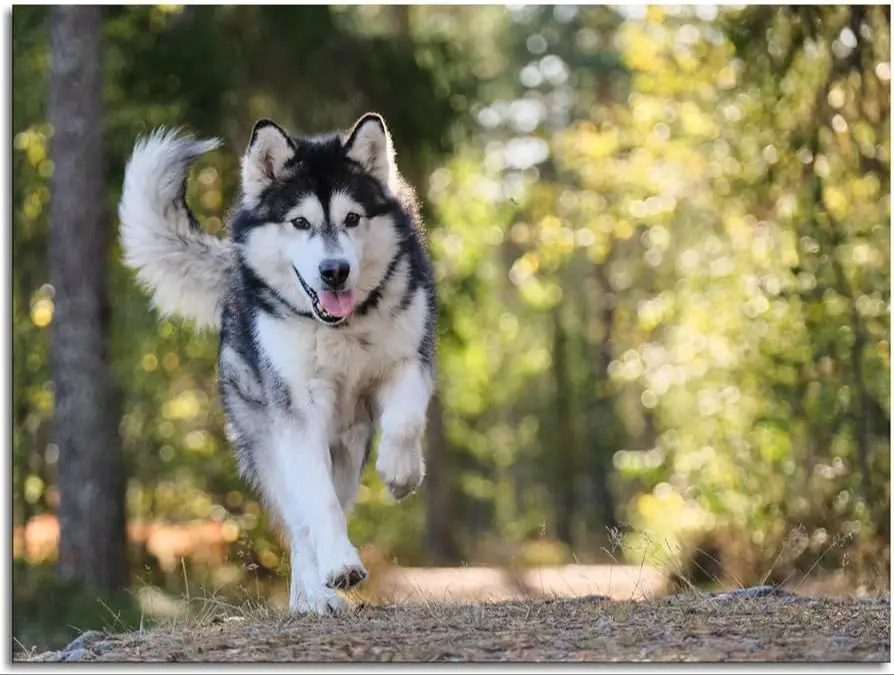Introducing the Alaskan Malamute
The Alaskan Malamute is an ancient sled dog breed that originated in the Arctic region of Alaska. According to the American Kennel Club (AKC), Malamutes are one of the oldest Arctic sled dog breeds and were bred by an Inuit tribe called the Mahlemiut in northwest Alaska over 2,000 years ago (source). They were highly valued by the Mahlemiut for their strength, endurance, and ability to haul heavy loads while working and traveling in harsh arctic conditions.
Malamutes were essential to the survival and livelihood of the Mahlemiut people. They helped tribesmen hunt, pull sleds loaded with supplies, and assisted in the transportation of camps. Malamutes had to be incredibly hardy and resilient to perform such demanding work in frigid climates and harsh terrain. Their thick coats, large size, and steady temperaments made them well-suited for these purposes.
The Malamute breed gets its name from the Mahlemiut tribe and the Malemiut region of Alaska where it was originally developed. They were later bred with other large breeds which produced an even larger, stronger sled dog. The Alaskan Malamute remains a popular sled dog today, continuing its legacy of working in the challenging conditions of Alaska.

Appearance of the Alaskan Malamute
The Alaskan Malamute is a large, powerfully built dog with a dense, weatherproof coat. According to the AKC breed standard, male Malamutes stand 25 inches tall at the shoulder and weigh around 85 pounds, while females stand 23 inches tall and weigh around 75 pounds.
Malamutes have a broad head, erect ears, and dark almond-shaped eyes that convey a friendly yet wolf-like expression. Their thick double coat consists of a coarse outer layer and a soft, dense undercoat. Common coat colors include various shades of gray, black, sable, and red. White markings are common on the face, legs, and underbelly.
The Malamute has a bushy tail that curls up and over the back; this helps insulate their face while they sleep. Their paws are large, round, and heavily furred as an adaptation for walking on snow.
While similar in appearance to the Siberian Husky, the Malamute is bulkier and heavier due to its working origins pulling heavy sleds. The Malamute also has a longer coat than the Husky. Overall, the Malamute conveys power and endurance with its sturdy physique.
References:
https://www.akc.org/dog-breeds/alaskan-malamute/
Temperament of the Alaskan Malamute

The Alaskan Malamute is known for its loyal, friendly, energetic personality. Although they were bred as working dogs, Malamutes thrive when they are part of a family. They form strong bonds with their owners and aim to please. Malamutes are very affectionate and love spending time with their families.
Malamutes have high energy levels and need a lot of exercise and mental stimulation. They love being active and spending time outdoors. Malamutes enjoy activities like hiking, backpacking, jogging, skijoring, carting, and swimming. Their energetic personality means they need a lot of interaction and playtime.
While Malamutes are usually very friendly, early socialization is important. Exposure to new sights, sounds, people and animals will ensure Malamutes grow into well-rounded, confident adults. With proper training, Malamutes get along well with children, other pets and strangers.
Malamutes are intelligent and independent thinkers. They can have a stubborn streak and will test boundaries, so they need dedicated training and firm leadership from an early age. With positive reinforcement training focused on respect and cooperation, Malamutes respond very well.
Overall, the Alaskan Malamute has an amazing temperament – loyal, friendly, energetic and affectionate. They thrive as part of an active family and with proper training and socialization, Malamutes make wonderful family companions.
Comparing the Malamute to the Siberian Husky
The Alaskan Malamute and Siberian Husky share many similarities, but there are some key differences between these two Arctic breeds. While the Malamute and Husky were both bred as working sled dogs, their specific purposes led to distinct sizes, appearances, and temperaments.
In terms of size, the Malamute is significantly larger and heavier than the Siberian Husky. On average, male Malamutes stand 25-27 inches tall and weigh 85-100 pounds, while female Malamutes are 23-25 inches tall and weigh 75-85 pounds. Siberian Husky males stand 21-24 inches tall and weigh 45-60 pounds, while females are 20-22 inches tall and weigh 35-50 pounds.
The Malamute has a bulkier, larger bone structure overall compared to the leaner Siberian Husky. The Malamute’s head is broad and deep with small, erect ears. The Husky’s head is finely chiseled with tall, pointed ears. The Malamute tail is furry and curls over the back, while the Husky tail is furry but hangs down straight. Both breeds boast thick double coats suited for frigid climates.
In terms of temperament, the Alaskan Malamute has a more mellow, dignified demeanor compared to the energetic, free-spirited Siberian Husky. The Malamute was bred to work cooperatively in a pack setting, so they are more sociable and friendly with strangers than the independent-minded Husky. Huskies are prone to more hyperactivity and require more exercise and stimulation than Malamutes overall.
While the Malamute and Husky share many similarities as Arctic dog breeds, their differences in size, appearance, and temperament stem from their distinct purposes – the Malamute’s job was heavy freighting, while the Husky’s role was faster sled pulling over long distances.
Malamute Size
The Alaskan Malamute is a large, powerfully built dog. According to the American Kennel Club breed standard, the average height range for males is 25-27.5 inches and 23-25 inches for females. Their weight can range from 75-85 pounds for males and 75 pounds for females.
According to Wikipedia, the average height of the Alaskan Malamute is 23-25 inches and their average weight is 75-85 pounds. The American Kennel Club describes the desired size as 23 inches tall and 75 pounds for females.
The typical lifespan of the Alaskan Malamute is 10-12 years. They are slower to mature than other dog breeds and may reach their full size around age 2.
Overall, the Alaskan Malamute is significantly larger and heavier than their close cousin, the Siberian Husky. Their substantial size makes them better suited for heavy pulling and hauling loads.
Malamute Exercise Needs

Alaskan Malamutes were bred as working dogs and need a great deal of daily exercise to keep them happy and well-behaved. According to veterinarians, Malamutes require a minimum of two hours of exercise per day to prevent behavioral issues [1]. However, most Malamute owners recommend even more exercise – at least 1-2 hours per day.
Malamutes have very high energy levels and stamina. Without sufficient outlets for exercise, Malamutes may become bored, restless, and destructive. Daily walks are not enough to meet their needs. Malamutes thrive on intense activities like hiking, running, backpacking, sledding, and swimming.
Potential Malamute owners need to be prepared to provide their dog with vigorous daily exercise. Malamutes that don’t get adequate exercise will likely develop behavioral problems like excessive barking, chewing, digging, and hyperactivity. Providing a Malamute with proper exercise will result in a happier, healthier, and better-behaved dog.
Grooming Requirements
The Alaskan Malamute has a very thick double coat that needs regular brushing and grooming. Their undercoat is soft and dense, while the outer coat contains guard hairs that are coarse and water repellent.
Malamutes shed heavily twice a year during seasonal shedding cycles in the spring and fall. Daily brushing is recommended during shedding season to control loose hair. A shedding blade, slicker brush, or undercoat rake can help remove dead undercoat and minimize shedding around the home. [Source here]
Outside of seasonal shedding, aim for brushing 2-3 times per week. Frequent brushing keeps their coat clean, minimizes tangles, and reduces overall shedding. Pay close attention to areas prone to matting like behind the ears, belly, and tail.
Due to their double coat, Malamutes only need occasional bathing every 6-10 weeks. Overbathing can damage their protective oils and cause skin irritation. Use a moisturizing dog shampoo and thoroughly rinse out all soap residue.
Other grooming needs include regularly trimming nails, cleaning ears, and brushing teeth. Overall, the Malamute’s grooming needs are moderate with weekly brushing and minimal professional grooming required.
Training a Malamute
Alaskan Malamutes are highly intelligent dogs that can be trained, but they require patience and consistency due to their strong-willed nature. Early socialization is key for Malamutes starting as young puppies. Exposing them to a variety of people, animals, places and experiences will help make them more well-rounded companions.

Reward-based training methods using praise, treats and toys work best for this breed. Positive reinforcement helps bring out their innate playfulness and eagerness to please their owners. However, Malamutes will test boundaries, so owners must be firm, consistent pack leaders.
Obedience training and basic commands like sit, stay and come should begin early and be regularly practiced. Malamutes respond best to short, engaging sessions that feel like a game. Harsh reprimands or punishment can cause them to shut down. Instead, redirecting unwanted behaviors into positive outlets works better over time. With dedication and an emphasis on forming a bond, Malamutes can learn to be well-behaved companions.
For more in-depth tips, check out “How to Train Alaskan Malamute Dogs” (https://pethelpful.com/dogs/How-To-Train-Alaskan-Malamute-Dogs).
Malamute Health
The Alaskan Malamute, while generally a healthy breed, does have some common health issues to look out for. These include:
- Hip and elbow dysplasia – This is a degenerative condition where the hip/elbow joints don’t fit together properly, causing pain and decreased mobility. Responsible breeding and keeping puppies at a healthy weight can help prevent this issue (PetMD).
- Hypothyroidism – This is where the thyroid gland doesn’t produce enough of certain important hormones. Symptoms can include hair loss, weight gain, lethargy and more. It can be managed with daily medication (AhcFargo).
- Eye issues – Malamutes can be prone to conditions like cataracts and progressive retinal atrophy later in life, which can cause vision loss. Regular eye exams by a vet are recommended (Embrace Pet Insurance).
- Polyneuropathy – This nerve disease can cause weakness, unsteadiness, paralysis and even death. Alert your vet quickly if you notice any unusual symptoms (PetMD).
Being aware of potential health problems beforehand allows owners to catch issues early and seek treatment. Work only with responsible breeders who test breeding dogs for known genetic conditions.
Is the Alaskan Malamute Right for You?
The Alaskan Malamute can make a wonderful pet for the right owner. They are known to be loyal, affectionate, and great with children. However, they do have some challenging traits that require an experienced owner.
On the positive side, Malamutes are playful, gentle giants that enjoy being around family. They are intelligent and respond well to patient, positive training methods. Malamutes generally get along with other dogs and do not have an aggressive tendency toward people. With early socialization, they can adapt well to life with children and make loving family companions.
Potential challenges include the Malamute’s enormous size and strength. They need consistent leadership and training from a confident owner. Malamutes have a high prey drive and can be destructive if bored or not exercised enough. They are heavy shedders that require daily grooming. Malamutes also tend to have a strong independent streak that makes recall training difficult.
Overall, the Alaskan Malamute is best suited to experienced owners who can provide structure, training, and activity to meet this breed’s needs. They need space to run around and should not be left alone for long periods. With the right owner, Malamutes can be wonderful, devoted pets that bring joy for years to come.
